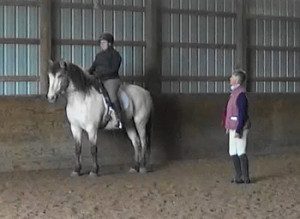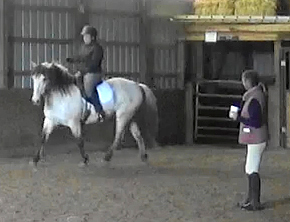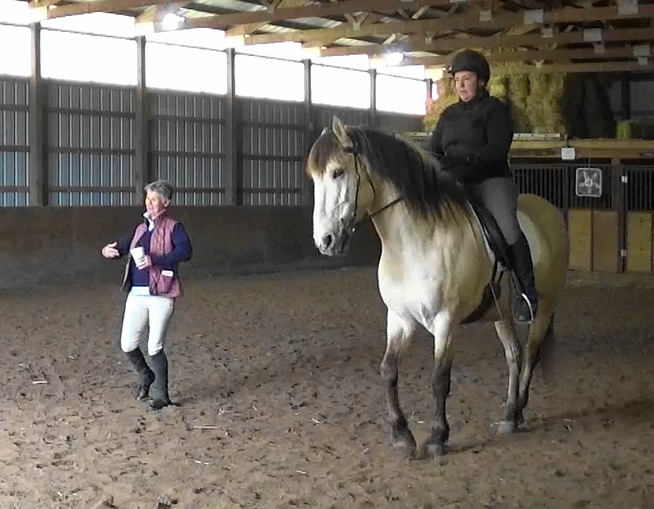By Jennifer Klitzke
In 2013 my Spanish Mustang Indian’s Legend (Indy) and I were acquainted with classical French Dressage when we rode at the Susan Norman Clinic. She has been a 15 year student of the late Jean Claude Racinet and a 3 year student of Philippe Karl, both whom I have been studying via books and DVDs since our lesson with Susan in 2013. Learning through books and DVDs can be helpful, but nothing compares to one-on-one instruction which provides timely feedback on how information is being interpreted. Plus, the lesson information is custom tailored to my horse’s needs versus a book’s or DVD’s general audience.

On May 14-15, 2016, Indy and I traveled to Timberlein Ranch in Stacy, MN to ride with Susan Norman. I think I learned just as much, if not more, from watching the other riders’ lessons—some riding green horses and others riding school masters.
Indy and I took in many new exercises to help us increase balance, lightness and harmony; rider position; the timing and application of aids; and entertain Indy’s keen mind from getting bored. Exercises include: figure eights with one loop of true bend to one loop of counter bend while transitioning between walk-halt-walk and trot-walk-trot transitions; leg yields from corner to corner across the diagonal; leg yields of three steps down the center line followed by three steps of straight followed by three more steps of leg yield; and spiraling in and out on a circle at a walk and trot. I noticed immediately improvement in Indy’s bend the moment Susan corrected my application of rider aids when I sat to the inside of the bend and applied my inside calf at the girth (instead of slightly behind the girth where my leg likes to hang.)
Working in Hand: Susan is a big advocate for teaching the horse work in hand before riding. I have to confess that I haven’t spent much time with this, so I asked her to show me how to introduce work in hand with Indy. Susan said it is important that the horse learns forward before teaching rein back or lateral movements. She showed me how to encourage Indy forward by tugging the reins on the back of his neck and walking alongside him for a couple steps and then halting him by alternating a squeeze release of each hand as each front foot steps. She repeated this exercise along the wall for a few minutes in each direction.

Once the horse is willingly forward, then rein back can be introduced. It is important to teach the horse to relax the jaw. Never push the horse back with the bit to force a rein back. This only creates tension in the horse and heaviness in the shoulders. When the horse is relaxed in the jaw and softly chewing the bit, the horse will rein back with little to no rein contact, no whip needed, and will be light in the shoulders.
Susan commended me for not forcing Indy’s active mouth shut with a crank nose band, and she praised me for not demanding him to be “on the bit.” Later on in the lesson, Susan pointed out how the balancing, softening, and lightening exercises naturally brought Indy to find his position on the bit.
Another insight from Susan was whenever Indy’s haunches fell in, Susan suggested, instead of forcing his haunches out, to move his shoulders in by bringing both hands to the inside and riding a shoulder fore position.
I was pleased with the progress Indy has made over the last three years from the first lesson I took with Susan and the study we have been doing through Philippe Karl’s DVD series and Jean Claude Racinet’s book “Another Horsemanship.” Indy doesn’t lean on the bridle like he did, nor does he dip his nose behind the vertical to evade the bit. He doesn’t rush off on the forehand and try to pull the reins out of my hands. Instead he is able to carry his own head and neck in a more elegant position for longer periods of time. Indy still has an active mouth and bobs his head at a walk, but Susan feels this will lessen in time. French classical dressage has really helped Indy, who is naturally built like a bulldozer, to carry himself lightly and politely into elegant balance which transforms our rides into more of a dance.
At the end of our ride, a kind woman approached Indy and I and said, “Thank you for bringing your lovely Fjord.” I had to giggle, since this comment pops up at every event I take Indy to, but it also provides the opportunity to talk about how wonderful my Spanish Mustang is.
Photo Gallery: (Click to enlarge)

